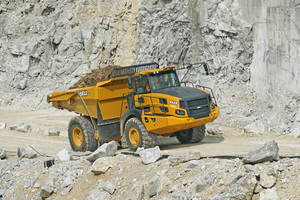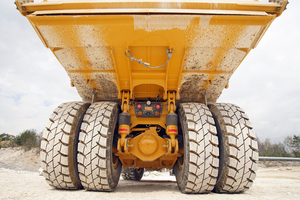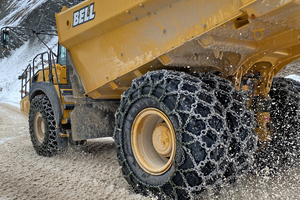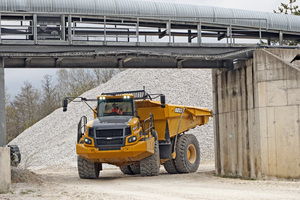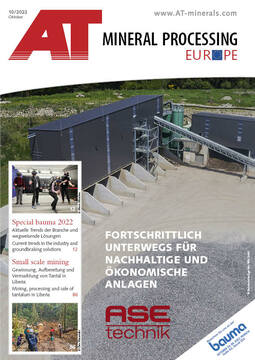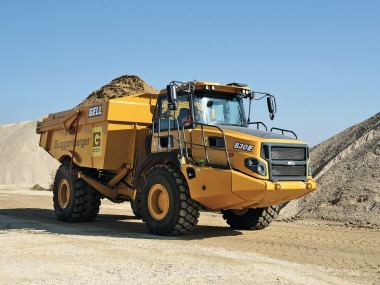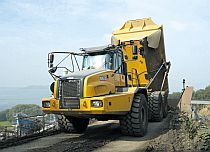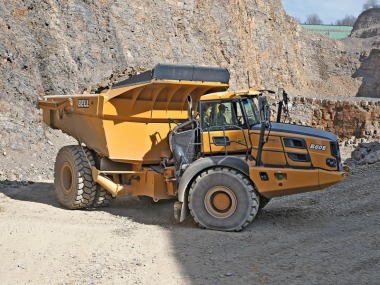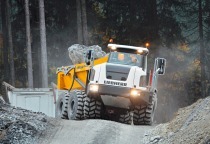Bell Equipment GmbH
As a supplement to its range of seven “traditional” 6x6 ADTs, with payloads from 18 000 to 45 400 kg, Bell Equipment is the only manufacturer of articulated haulers in the world to offer a parallel range of two-axle ADTs for the past six years. All three models are aimed at different market segments and are strong offerings thanks to the advantages of the 4x4 ADT concept. In the right applications they outperform conventional rigid dump trucks that need good haul roads and the three-axle ADTs designed for extreme off-road mobility.
At the upper end, the Bell B60E 4x4 – with a 55-tonne payload and 35 m³ dump body capacity, is now a benchmark for all-weather operations on undulating ground in opencast mines or large quarries. At the bottom of the range, the Bell B30E 4x4 (28 t; 18,5 m³) is a convincing compact and highly economical solution for sand and gravel pits, material handling or underground operations.
At home in the quarry
The second-generation Bell B45E 4x4 (41 t; 25 m³) is aimed at small to medium-sized quarry operations. Here it competes against rigid trucks in the 45- to 55-tonne class or 6x6 ADTs with payloads of 40 tonnes or more. Compared to both types of vehicles, the 4x4 truck shows its strengths to the full in typical hard-stone quarrying on rough ground with steep climbs and tight bends.
In wet weather, conventional 4x2 rigid tippers quickly reach their limits. The all-wheel drive and oscillation joint of the Bell B45E 4x4 always ensure high traction, and the retarder and service brakes can be applied in a very controlled manner even under full load thanks to constant ground contact by all tyres. The high power to weight ratio keeps cycles times low in difficult weather conditions and extends production times in exposed quarries. In addition, the Bell B45E 4x4 can be also used in overburden or new excavations. While this machine does not excel in soft underfoot conditions like its 6x6 counterpart, its twin-tyred single rear axle brings substantial advantages over 6x6 ADT tandem axles on hard roads. In tight corners the tandem axle experiences significant tyre wear and wears the road down. In addition, there is greater manoeuvrability thanks to the shorter rear chassis, which, together with the rock bin typical of quarries, results in faster cycles on the quarry faces or at the primary crusher.
Triggered by the company-wide transition of all Bell ADTs to EU Stage V, it was decided to revise the first generation. In addition to the Stage 5 improvements, a number of changes were incorporated based on user feedback from practical tests and initial customer placements.
Better driving – better loading
The most significant changes relate to the rear end of the Bell B45E 4x4. The rear axle is now suspended and the bin has been heavily modified. Despite this, the frame length and wheelbase remained almost identical, making the two-axle articulated truck highly manoeuvrable (max. turning circle: 17.31 m).
As with the 60-tonne Bell B60E 4x4, two oil/nitrogen hydro-pneumatic struts now take over the suspension of the rear axle from German manufacturer, Kessler. In combination with the standard adaptive “Comfort-Ride” front suspension, this provides significantly more driving comfort for a vehicle that weighs around 79 tonnes when loaded. In addition to a limited slip differential, the rear axle now also features sensor-supported automatic traction control. The new suspension geometry and kinematics have been designed to allow the 21.00 R35 twin tyres to be fitted with snow chains.
The exhaust-heated rock bin with flat bottom has been completely redesigned: For better matching with the wheel loaders, often typical in small to medium-sized quarries, the standard bin has been lengthened and given a straight front wall. This gives a longer top edge of the body and better filling speed with wide 3,5 to 6 m³ rock shovels (bin height: 3485 mm). Both the maximum tipping height (6485 mm at 55°) and the large ground clearance of the chute (890 mm) remain almost unchanged. This means that the articulated 41-tonne two-axle truck can be fitted into existing infrastructures (e.g., crusher enclosures) much more easily than comparable 6x6 articulated trucks with a long earthmoving body but offers their advantages over conventional rigid tippers that have a low tip clearance when unloading quickly on any terrain. As an alternative to the 4265 mm wide 25 m³ standard body (with tailgate: 26 m³/4639 mm), a narrower version of the same capacity is now available as an option, ensuring the vehicle width under 4,0 m with tailgate. The slightly longer “narrow” body with raised bin height (3671 mm) can be loaded with heavy wheel loaders but also works well with excavators.
Cutting-edge technology from large-scale production
The Bell B45E 4x4 has an almost identical front end to its 6x6 sister model, the B45E. This means that operators benefit from Bell Equipment’s continuously developed 6x6 articulated large-series technology in terms of drive, power transmission and intelligent vehicle control. Under the bonnet is the 390 kW in-line six-cylinder OM471LA from Mercedes-Benz. Exhaust gas treatment to the requirements of EU Stage V is handled by a low-maintenance system consisting of controlled exhaust gas recirculation (EGR), SCR technology and a diesel particulate filter. Together with the “self-learning” Allison seven-speed automatic 4700 ORS, the torque-optimised engine (2460 NM at 1300 rpm) ensures high fuel efficiency, which is reflected in low consumption rates. As with the other current Bell large ADTs, multi-disc wet brakes on both axles work in collaboration with the Jacobs engine brake to provide automatic retardation when the operator releases the accelerator pedal.
The workplace in the spacious Bell standard cab of the B45E 4x4 offers good visibility, high comfort and a complete standard package of driver-related assistance systems. These include, for example, Hill Assist as well as loading and tipping routines that ensure productivity and safety in equal measure. All electronic assistance and status displays are based on real-time measurement data from the networked vehicle sensors (on-board scales, tilt and roll sensors, etc.). Much of this information is also available for computer analysis and tracking using Bell’s satellite-based machine monitoring system, Fleetm@tic®.
In addition to the presentation of further models – including the Bell B30E “Narrow”, a particularly economical solution in heavy earthworks with official German road approval – Bell Equipment will also be providing information in Munich on programme-wide further development of its current E-series. This includes further simplifications in operation through new operating functions, and new features in the Bell Fleetm@tic® fleet management software. In addition, customer service specialists from all global Bell sales regions will provide information on the further expanded service packages for all industries and markets.
Booth C6.303

